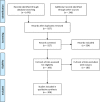Malaria resurgence: a systematic review and assessment of its causes
- PMID: 22531245
- PMCID: PMC3458906
- DOI: 10.1186/1475-2875-11-122
Malaria resurgence: a systematic review and assessment of its causes
Abstract
Background: Considerable declines in malaria have accompanied increased funding for control since the year 2000, but historical failures to maintain gains against the disease underscore the fragility of these successes. Although malaria transmission can be suppressed by effective control measures, in the absence of active intervention malaria will return to an intrinsic equilibrium determined by factors related to ecology, efficiency of mosquito vectors, and socioeconomic characteristics. Understanding where and why resurgence has occurred historically can help current and future malaria control programmes avoid the mistakes of the past.
Methods: A systematic review of the literature was conducted to identify historical malaria resurgence events. All suggested causes of these events were categorized according to whether they were related to weakened malaria control programmes, increased potential for malaria transmission, or technical obstacles like resistance.
Results: The review identified 75 resurgence events in 61 countries, occurring from the 1930s through the 2000s. Almost all resurgence events (68/75 = 91%) were attributed at least in part to the weakening of malaria control programmes for a variety of reasons, of which resource constraints were the most common (39/68 = 57%). Over half of the events (44/75 = 59%) were attributed in part to increases in the intrinsic potential for malaria transmission, while only 24/75 (32%) were attributed to vector or drug resistance.
Conclusions: Given that most malaria resurgences have been linked to weakening of control programmes, there is an urgent need to develop practical solutions to the financial and operational threats to effectively sustaining today's successful malaria control programmes.
Figures





Comment in
-
Relegating malaria resurgences to history.Malar J. 2012 Apr 24;11:123. doi: 10.1186/1475-2875-11-123. Malar J. 2012. PMID: 22531295 Free PMC article.
References
-
- Roll Back Malaria Partnership. A decade of partnership and results. World Health Organization, Geneva; 2011.
-
- World Health Organization. World Malaria Report 2010. Geneva: World Health Organization; 2010.
-
- Bruce-Chwatt LJ. Resurgence of malaria and its control. J Trop Med Hyg. 1974;77:s62–s66. - PubMed
-
- Gabaldon A. Vector control and the recrudescence of vector-borne diseases: Proceedings of a Symposium held during the Tenth Meeting of the PAHO Advisory Committee on Medical Research, 15 June 1972. Publ. No. 238. D.C.: Pan Am Hlth Org Sci Washington; 1972. Recrudescence of malaria; pp. 23–41.
-
- Nájera JA, Kouznetsov RL, Delacollette C. Malaria epidemics: detection and control, forecasting and prevention. Division of Control of Tropical Diseases: World Health Organization; 1998.
Publication types
MeSH terms
LinkOut - more resources
Full Text Sources
Other Literature Sources
Medical
Miscellaneous

